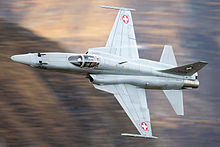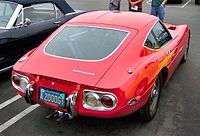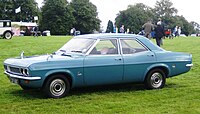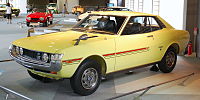Coke bottle styling

Coke bottle styling is an automotive body design with a narrow center surrounded by flaring fenders.[1][2] This design element bears a general resemblance to a Coca-Cola classic glass contour bottle design,[3] and was inspired by the tapering middle fuselage of contemporary fighter jets. Industrial designer Raymond Loewy, who in 1955 had re-designed the actual Coke bottle as well,[4] introduced it on the radical 1962 Studebaker Avanti gran turismo.[5]
Origin
The design was pioneered in fighter jets to significantly reduce the sharp drag rise at transonic speed and supersonic speeds. Using this design often results in a pinch-waisted fuselage shape that National Advisory Committee for Aeronautics (NACA) labeled the design principle the "area rule" and variously identified as a coke bottle, wasp waist, or Marilyn Monroe shape (i.e. an hourglass figure).[6][7] The area rule design technique is most effective between Mach 0.75 and 1.2, or at speeds over 575 mph (925 km/h). The design technique on automobiles provides a visual attraction, but negligible performance improvement.[citation needed]
Development

The exotic shapes of early supersonic fighter jets dramatically influenced automobile stylists. First, the tailfin fad, appeared in the mid-1950s and was on the decline by the early 1960s, then the "Coke bottle" look of severely wasp-waisted high-performance jet fighters, such as the Northrop F-5.[8][2] The initial result was luxury performance automobiles, such as the 1962 Studebaker Avanti and 1963 Buick Riviera, earned this term "by having more rounded body panels with arcs over the wheelwells, making them resemble bottles of Coca-Cola laid on their sides."[9]
United States
Studebaker introduced the Raymond Loewy-designed Avanti gran turismo with pronounced Coke bottle look in 1962.[10] The 1962 Pontiac full-size models also "had a subtle horizontal crease about halfway down [the bodyside] and a slight wasp-waist constriction at the doors which swelled out again in the rear quarters"[11] One of the cleanest examples of the "Coke bottle" styling was the 1963 Buick Riviera,[12] a pioneering personal luxury car. Chevrolet first applied the Coke bottle look on Bill Mitchell's 1963 Corvette Sting Ray.[13] The styling of the 1962 through 1968 versions has been described "like a bottle of Coke on wheels" because of the long hood and "powerful wheel arches".[5]

By 1966, the General Motors A-body sedans received a mid-riff pinch and "hop up" fenders. Intermediates such as the 1968-1970 Dodge Charger and Ford Torino followed suit, as well as compacts such as the Ford Maverick and Plymouth Duster. General Motors also styled their "B" body full-size cars from 1965 to 1968 with this style, which is most prominent on the "fastback" 2-door hardtop models. Chrysler's "interpretation of the Coke-bottle styling treatment to its struggling B-body cars ... [resulted in] ... smooth lines, subtly rounded curves, and near perfect proportions."[14] Notable automobiles with this style include many of the muscle cars during this era, such as the Pontiac GTO, Chevrolet Camaro, and Dodge Charger.[3][2]
Design "themes" such as the "hop up" fenders became so pervasive across the industry that American Motors' all-new 1967 Rebel was criticized because "viewed from any angle, anyone other than an out-and-out car buff would have trouble distinguishing the Rebel from its GM, Ford, and Chrysler Corp. competition."[15][16] However, AMC discovered that compared to slab styling with deeply sculpted ridges, "the rounded "Coke-bottle" panels would be easier to make and the dies would last longer — an important cost consideration."[17]
Author Clinton Walker described the archetypal product of Australian suburbia, the muscle car, with its "Coke bottle hip bump but the midriff of a go-go dancer?"[18] According to automotive historian Darwin Holmstrom, Chevrolet "took it to its illogical extreme with the 1968 Corvette, though that car more closely resembled a prosthetic phallus than a Coke bottle".[19]
By the late-1970s and early-1980s, cars like the Ford Fairmont and Chrysler K-cars moved towards straight lines. The Audi 100 (C3) and Ford Taurus led towards functional aerodynamic styling.
International markets
This styling "was to be seen right across the marketplace and, before long, around the world".[12] Japanese, European, and Australian automobiles also adopted this style during the latter 1960s and into 1970s.
In Japan, Toyota released the curvaceous limited production Toyota 2000GT in 1967, characterized by its "flowing design" and "Coke Bottle Shape".[5] Other period Toyota Coke bottle designs include the 1972-1976 Toyota Corona Mark II[broken anchor] and the Toyota Celica. Japanese automaker Nissan offered this appearance on the 1970s-era Nissan Cedrics, Nissan Glorias, Nissan Laurels, Nissan Bluebirds, and Nissan Violets. Mitsubishi also adopted this appearance on the 1973 through 1980 Galant and the 1973-1979 Lancer. The smallest car with this style is usually considered to be the 1967 Suzuki Fronte 360, which was less than 3 m (10 ft) long,[20] while the Subaru 360 also used similar styling elements, notably the curvaceous "belt line".
Examples
- AMC Ambassador (1967-1969) [21][22]
- AMC Javelin (1968-1974) [2][23]
- Buick Riviera (1963-1965) [9]
- Chevrolet Camaro (1967-1969) [24]
- Chevrolet Corvair (1965–1969) [25]
- Chevrolet Impala (1965–1970) [26]
- Corvette Sting Ray (1963-1967) [13]
- Dodge Charger (1968-1970) [27]
- Studebaker Avanti (1963-1964) [28]
Gallery
-
1965 Pontiac Bonneville
-
1966 Lamborghini Miura P400[2]
-
1967 Chevrolet Camaro
-
1967-1969 Toyota 2000GT
-
1967-1971 Opel Commodore A
-
1967-1972 Vauxhall Victor FD
-
1969 Chevrolet Corvette
-
1970 Toyota Celica
-
1971 AMC Javelin
-
1973-1976 Ford Falcon XB
See also
References
- ^ "Plymouth Belvedere and Plymouth Satellite". allpar.com. 20 November 2016. Retrieved 24 February 2022.
- ^ a b c d e f g Young, Aaron (13 March 2021). "Ranking The Greatest "Coke Bottle" Car Designs Of All Time". HotCars. Retrieved 13 February 2024.
- ^ a b Breitenstein, Jeff; Paiva, Troy (2004). Ultimate Hot Rod Dictionary: A-Bombs to Zoomies. MBI Publishing. p. 53. ISBN 978-0-7603-1823-2. Retrieved 30 March 2016.
- ^ "The History Behind the Coca-Cola Bottle". The Coca-Cola Company. Archived from the original on 19 August 2019. Retrieved 20 October 2019.
When King and Family sized packaging were introduced in 1955, Raymond Loewy was part of the team that worked to recast the bottle but still keep the proper proportions.
- ^ a b c Rzyski, Alfred. "Design: Drink a Coke, drive a Coke". ramp.space. Retrieved 13 February 2024.
- ^ Algeo, John, ed. (1993). Fifty Years Among the New Words: A Dictionary of Neologisms, 1941-1991. Cambridge University Press. p. 146. ISBN 978-0-521-44971-7. Retrieved 30 March 2016.
- ^ Heversi, Dennis (25 October 2009). "Richard T. Whitcomb Is Dead at 88; Revolutionized the Design of Jet Aircraft". The New York Times. Retrieved 30 March 2016.
- ^ Warwick, Graham (17 April 2006). "Flying Sideways". Flightglobal.com. Retrieved 13 February 2024.
- ^ a b Holmstrom, Darwin (2016). American Muscle Cars: A Full-Throttle History. Motorbooks. p. 130. ISBN 978-0-7603-5013-3. Retrieved 30 March 2016.
- ^ Jedlicka, Dan. "1963-64 Studebaker Avanti". danjedlicka.com. Retrieved 24 February 2022.
- ^ Wilson, Paul Carroll (1976). Chrome dreams: automobile styling since 1893. Chilton. p. 269. ISBN 978-0-8019-6352-0. Retrieved 30 March 2016.
- ^ a b Car: The Definitive Visual History of the Automobile. DK Publishing. 2011. p. 186. ISBN 978-0-7566-8938-4. Retrieved 30 March 2016.
- ^ a b Mueller, Mike (2002). Chevelle. MotorBooks. p. 59. ISBN 978-0-7603-1484-5. Retrieved 30 March 2016.
- ^ Leffingwell, Randy; Holmstrom, Darwin (2006). Muscle: America's Legendary Performance Cars. MBI Publishing. p. 229. ISBN 978-0-7603-2284-0. Retrieved 30 March 2016.
- ^ Kilpatrick, Bill (October 1966). "1967: The Showdown Year". Popular Mechanics. Vol. 126, no. 4. p. 101. Retrieved 24 February 2022 – via Google Books.
- ^ "How American Motors abandoned its uniqueness in the second half of the 1960s". indieauto.org. 1 January 2020. Retrieved 13 February 2024.
- ^ Mitchell, Larry (2000). AMC Muscle Cars. Motorbooks. pp. 31–32. ISBN 978-0-7603-0761-8. Retrieved 24 February 2022 – via Google Books.
- ^ Walker, Clinton (2009). Golden Miles: Sex, Speed and the Australian Muscle Car (Revised ed.). Wakefield Press. p. 42. ISBN 978-1-86254-854-1. Retrieved 24 February 2022 – via Google Books.
- ^ Holmstrom, p. 130.
- ^ Ozeki, Kazuo (2007). Suzuki Story: Small Cars, Big Ambitions (in Japanese). Miki Press. p. 30. ISBN 978-4-89522-503-8.
- ^ Quella, Chad (16 November 2020). "The Spirit Is Still Alive: American Motors Corporation 1954-1987: 1967". allpar.com. Retrieved 24 February 2022.
Rebel, Marlin and the new, larger Ambassador wore sleek "Coke bottle" styling that was the fad at the time.
- ^ Cranswick, Marc (2012). The cars of American Motors: an illustrated history. McFarland. p. 73. ISBN 9780786446728. Retrieved 13 February 2024 – via Google Books.
Coke-bottle styling was being used on cars everywhere; AMC was staying abreast of fashion and came up with their first family car with style that rivaled function.
- ^ Strohl, Daniel (July 2005). "Attack of the Welterweight". Hemmings Muscle Machines. Retrieved 24 February 2022.
... in profile, it had a real Coke-bottle effect.
- ^ Robinson, Aaron (17 November 2023). "First-Gen Camaro (1967–69): The one that picked a fight". Hagerty. Retrieved 13 February 2024.
- ^ Cheetham, Craig (2006). Ultimate American Cars. MotorBooks/MBI. p. 74. ISBN 978-0-7603-2570-4. Retrieved 13 February 2024.
...with smooth Coke-bottle contours...
- ^ "1967 Chevrolet Impala". oldride.com. Retrieved 24 February 2022.
The Impala was redesigned and had a "coke bottle" shape that similar to the 1963 Buick Riviera.
- ^ Magnante, Steve (10 August 2012). "1968 Dodge Charger R/T 426 Hemi First Drive". Motor Trend. Retrieved 13 February 2024.
- ^ "1963-1964 Studebaker Avanti". How Stuff Works. 17 December 2007. Retrieved 13 February 2024.
A coke-bottle waist formed the base for a thin-section roof with a huge rear window and a built-in roll bar.

![1966 Lamborghini Miura P400[2]](http://upload.wikimedia.org/wikipedia/commons/thumb/1/15/Lamborghini_Miura_%28Kirchzarten%29_jm20695.jpg/200px-Lamborghini_Miura_%28Kirchzarten%29_jm20695.jpg)




![1968 Charger R/T[2]](http://upload.wikimedia.org/wikipedia/commons/thumb/d/df/1968_Dodge_Charger_R-T_-_Flickr_-_Highway_Patrol_Images.jpg/200px-1968_Dodge_Charger_R-T_-_Flickr_-_Highway_Patrol_Images.jpg)




![1972 Plymouth Barracuda[2]](http://upload.wikimedia.org/wikipedia/commons/thumb/8/86/PlymouthBarracuda.jpg/200px-PlymouthBarracuda.jpg)


